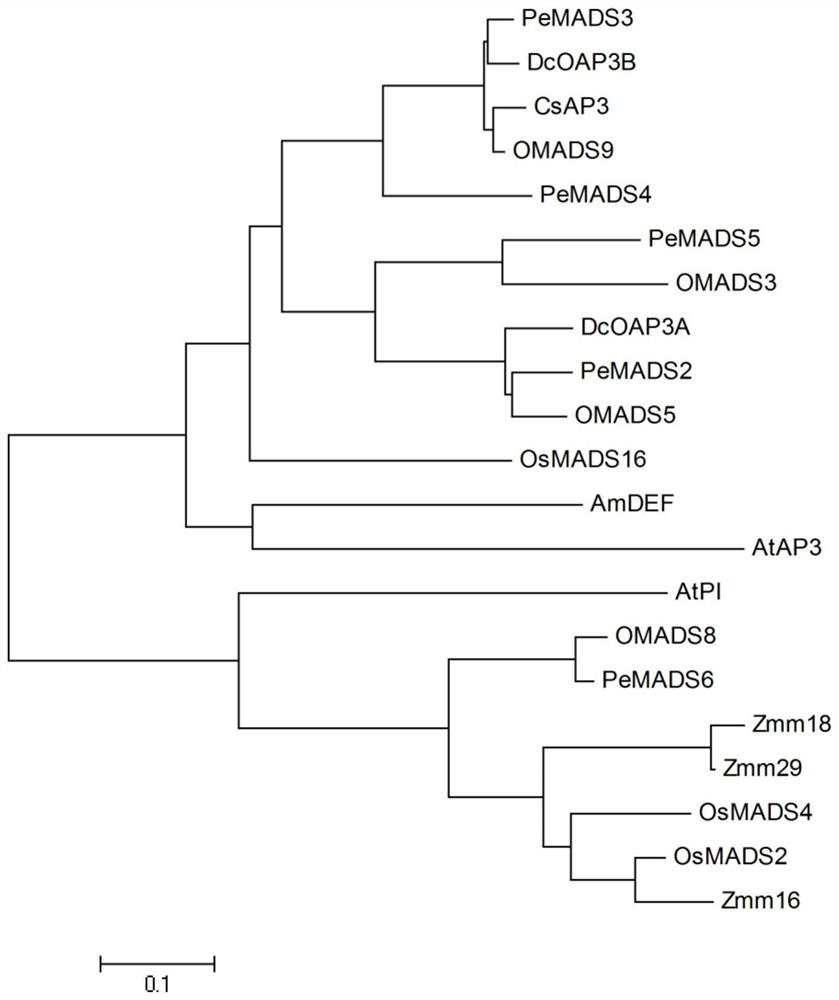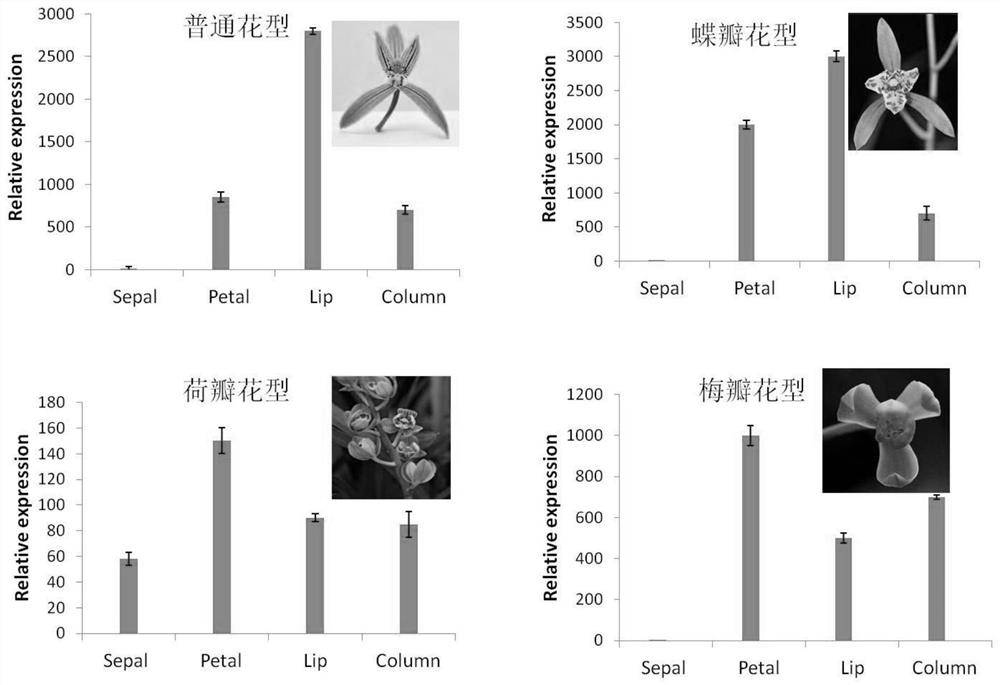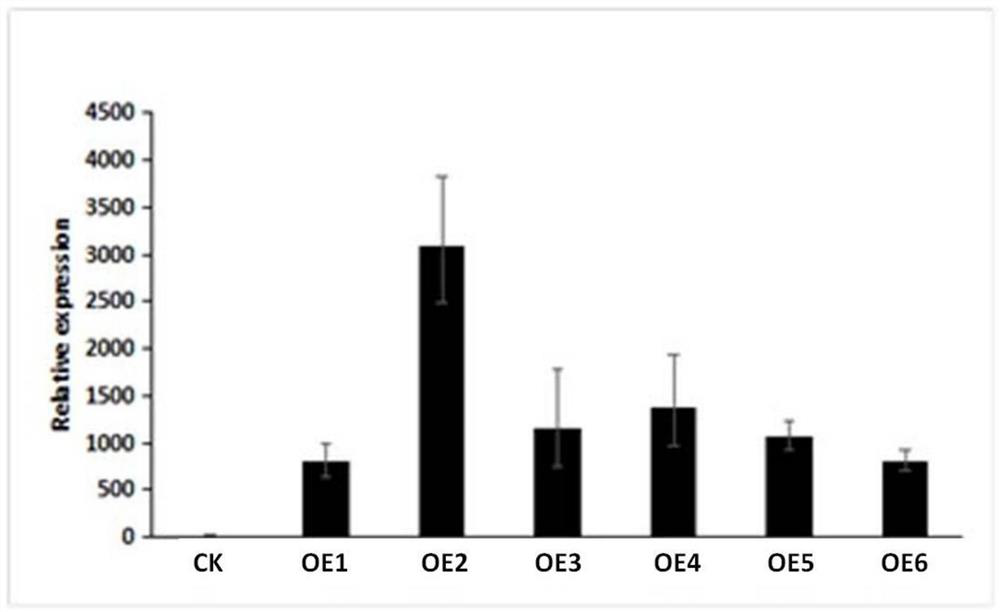Genes regulating organ development in Orchid chinensis and their encoded proteins and their application
A technology for regulating genes and regulating proteins, which can be used in applications, genetic engineering, plant genetic improvement, etc., and can solve the problems of long cycle and unpredictable traits.
- Summary
- Abstract
- Description
- Claims
- Application Information
AI Technical Summary
Problems solved by technology
Method used
Image
Examples
Embodiment 1
[0017] Example 1 Cloning and sequence analysis of CsAP3 gene
[0018] 1. RNA extraction
[0019] 2 g of the organ tissue of the cultivar Damo flower was taken, and its total RNA was extracted with plant Trizol (Invitrogen) reagent and reverse transcribed into cDNA (Thermo Scientific Revert Aid First Strand cDNA Synthesis Kit).
[0020] 2. Acquisition of the target gene CsAP3
[0021] Using CsAP3-F1: ATGGGGAGAGGGAAGATAGAGAT (SEQ ID NO: 3) and CsAP3-R1: TCAAGCGAGACGCAGATCAT (SEQ ID NO: 4) as primers, using the cDNA obtained in the above step 1 as a template, using Ex-Taq enzyme (TaKaRa Biotechnology Co.) PCR, according to the following conditions: 94°C for 4 min, then 34 cycles (94°C for 40s, 59.5°C for 40s, 72°C for 1.5min, 72°C for 10min). The PCR product was recovered from the agarose gel, then ligated to the pMD19-T vector (TaKaRa Biotechnology Co.) and sent to BGI for sequencing. Analysis of the sequencing results showed that the amplified fragment contained the complete...
Embodiment 2
[0025] Example 2 Expression pattern of CsAP3 in orchids
[0026] 1. RNA extraction
[0027] Take the young leaves, old leaves, roots, pseudobulbs, different tissues of flowers, and the sepals, petals, labial petals and pistil four-wheeled flower organs of the cultivar Damo of the cultivar Damo, 2 g each, using the plant Trizol ( Invitrogen) reagent was used to extract the total RNA, and 2 μl of it was reverse transcribed into cDNA using the Thermo Scientific RevertAid First Strand cDNA Synthesis Kit.
[0028] 2. Quantitative PCR
[0029]Using primers CsAP3QRT-F: AAGGCAAGCGAGCTGACTGT (SEQ ID NO: 5) and CsAP3QR T-R: CCATCCTCTGCCTGATCTCC (SEQ ID NO: 6), the expression of CsAP3 gene in different tissues of orchids was detected by real-time quantitative PCR. Ubiquitin QRT-F: CAAAGAAGGCATTCCACCAGAT (SEQ ID NO: 7) and Ubiquitin QRT-R: CCGAGTCCCCAACTTTGTAGAA (SEQ ID NO: 8) were used as primers, and Ubiquitin was amplified as an internal reference. The following procedure was follow...
Embodiment 3
[0033] Example 3 Functional analysis of CsAP3 gene in Arabidopsis
[0034] 1. Transformation of Arabidopsis thaliana high expression vector construction
[0035] Using the primers CsAP3-F1: ATGGGGAGAGGGAAGATAGAGAT and CsAP3-R1: TCAAGCGAGACGCAGATCAT to amplify the CDs sequence of the CsAP3 gene (ie, the CsAP3 gene, the nucleotide sequence is shown in SEQ ID NO: 1), and cloned into pMD19-Tvector (Takara ), sent to BGI for sequencing. After the sequencing was correct, using EcoRI and SacI double digestion (Thermo Fisher Scientific), the purified target fragment was recovered and ligated to the pBI121 vector purified by digestion with the same two enzymes and named pBI-AP3.
[0036] 2. Transforming Arabidopsis Plants
[0037] 2.1 Transformation of Agrobacterium GV3101
[0038] 1) Thaw the competent cells stored at -80°C on ice. After the cells are completely dissolved, add about 1 μg of plasmid (pBI-AP3), mix gently, and place on ice for 30 minutes.
[0039] 2) Quick-freeze in...
PUM
 Login to View More
Login to View More Abstract
Description
Claims
Application Information
 Login to View More
Login to View More - R&D
- Intellectual Property
- Life Sciences
- Materials
- Tech Scout
- Unparalleled Data Quality
- Higher Quality Content
- 60% Fewer Hallucinations
Browse by: Latest US Patents, China's latest patents, Technical Efficacy Thesaurus, Application Domain, Technology Topic, Popular Technical Reports.
© 2025 PatSnap. All rights reserved.Legal|Privacy policy|Modern Slavery Act Transparency Statement|Sitemap|About US| Contact US: help@patsnap.com



